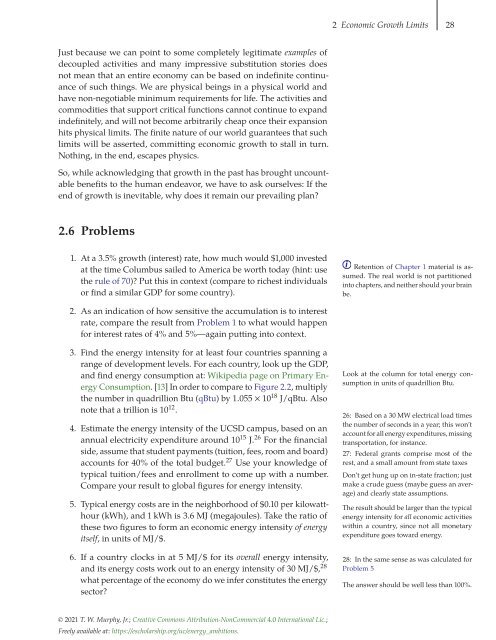Energy and Human Ambitions on a Finite Planet, 2021a
Energy and Human Ambitions on a Finite Planet, 2021a
Energy and Human Ambitions on a Finite Planet, 2021a
You also want an ePaper? Increase the reach of your titles
YUMPU automatically turns print PDFs into web optimized ePapers that Google loves.
2 Ec<strong>on</strong>omic Growth Limits 28<br />
Just because we can point to some completely legitimate examples of<br />
decoupled activities <str<strong>on</strong>g>and</str<strong>on</strong>g> many impressive substituti<strong>on</strong> stories does<br />
not mean that an entire ec<strong>on</strong>omy can be based <strong>on</strong> indefinite c<strong>on</strong>tinuance<br />
of such things. We are physical beings in a physical world <str<strong>on</strong>g>and</str<strong>on</strong>g><br />
have n<strong>on</strong>-negotiable minimum requirements for life. The activities <str<strong>on</strong>g>and</str<strong>on</strong>g><br />
commodities that support critical functi<strong>on</strong>s cannot c<strong>on</strong>tinue to exp<str<strong>on</strong>g>and</str<strong>on</strong>g><br />
indefinitely, <str<strong>on</strong>g>and</str<strong>on</strong>g> will not become arbitrarily cheap <strong>on</strong>ce their expansi<strong>on</strong><br />
hits physical limits. The finite nature of our world guarantees that such<br />
limits will be asserted, committing ec<strong>on</strong>omic growth to stall in turn.<br />
Nothing, in the end, escapes physics.<br />
So, while acknowledging that growth in the past has brought uncountable<br />
benefits to the human endeavor, we have to ask ourselves: If the<br />
end of growth is inevitable, why does it remain our prevailing plan?<br />
2.6 Problems<br />
1. At a 3.5% growth (interest) rate, how much would $1,000 invested<br />
at the time Columbus sailed to America be worth today (hint: use<br />
the rule of 70)? Put this in c<strong>on</strong>text (compare to richest individuals<br />
or find a similar GDP for some country).<br />
i Retenti<strong>on</strong> of Chapter 1 material is assumed.<br />
The real world is not partiti<strong>on</strong>ed<br />
into chapters, <str<strong>on</strong>g>and</str<strong>on</strong>g> neither should your brain<br />
be.<br />
2. As an indicati<strong>on</strong> of how sensitive the accumulati<strong>on</strong> is to interest<br />
rate, compare the result from Problem 1 to what would happen<br />
for interest rates of 4% <str<strong>on</strong>g>and</str<strong>on</strong>g> 5%—again putting into c<strong>on</strong>text.<br />
3. Find the energy intensity for at least four countries spanning a<br />
range of development levels. For each country, look up the GDP,<br />
<str<strong>on</strong>g>and</str<strong>on</strong>g> find energy c<strong>on</strong>sumpti<strong>on</strong> at: Wikipedia page <strong>on</strong> Primary <str<strong>on</strong>g>Energy</str<strong>on</strong>g><br />
C<strong>on</strong>sumpti<strong>on</strong>.[13] In order to compare to Figure 2.2, multiply<br />
the number in quadrilli<strong>on</strong> Btu (qBtu) by1.055 × 10 18 J/qBtu. Also<br />
note that a trilli<strong>on</strong> is 10 12 .<br />
4. Estimate the energy intensity of the UCSD campus, based <strong>on</strong> an<br />
annual electricity expenditure around 10 15 J. 26 For the financial<br />
side, assume that student payments (tuiti<strong>on</strong>, fees, room <str<strong>on</strong>g>and</str<strong>on</strong>g> board)<br />
accounts for 40% of the total budget. 27 Use your knowledge of<br />
typical tuiti<strong>on</strong>/fees <str<strong>on</strong>g>and</str<strong>on</strong>g> enrollment to come up with a number.<br />
Compare your result to global figures for energy intensity.<br />
Look at the column for total energy c<strong>on</strong>sumpti<strong>on</strong><br />
in units of quadrilli<strong>on</strong> Btu.<br />
26: Based <strong>on</strong> a 30 MW electrical load times<br />
the number of sec<strong>on</strong>ds in a year; this w<strong>on</strong>’t<br />
account for all energy expenditures, missing<br />
transportati<strong>on</strong>, for instance.<br />
27: Federal grants comprise most of the<br />
rest, <str<strong>on</strong>g>and</str<strong>on</strong>g> a small amount from state taxes<br />
D<strong>on</strong>’t get hung up <strong>on</strong> in-state fracti<strong>on</strong>; just<br />
make a crude guess (maybe guess an average)<br />
<str<strong>on</strong>g>and</str<strong>on</strong>g> clearly state assumpti<strong>on</strong>s.<br />
5. Typical energy costs are in the neighborhood of $0.10 per kilowatthour<br />
(kWh), <str<strong>on</strong>g>and</str<strong>on</strong>g> 1 kWh is 3.6 MJ (megajoules). Take the ratio of energy intensity for all ec<strong>on</strong>omic activities<br />
The result should be larger than the typical<br />
these two figures to form an ec<strong>on</strong>omic energy intensity of energy within a country, since not all m<strong>on</strong>etary<br />
expenditure goes toward energy.<br />
itself, in units of MJ/$.<br />
6. If a country clocks in at 5 MJ/$ for its overall energy intensity,<br />
<str<strong>on</strong>g>and</str<strong>on</strong>g> its energy costs work out to an energy intensity of 30 MJ/$, 28<br />
what percentage of the ec<strong>on</strong>omy do we infer c<strong>on</strong>stitutes the energy<br />
sector?<br />
28: In the same sense as was calculated for<br />
Problem 5<br />
The answer should be well less than 100%.<br />
© 2021 T. W. Murphy, Jr.; Creative Comm<strong>on</strong>s Attributi<strong>on</strong>-N<strong>on</strong>Commercial 4.0 Internati<strong>on</strong>al Lic.;<br />
Freely available at: https://escholarship.org/uc/energy_ambiti<strong>on</strong>s.


















